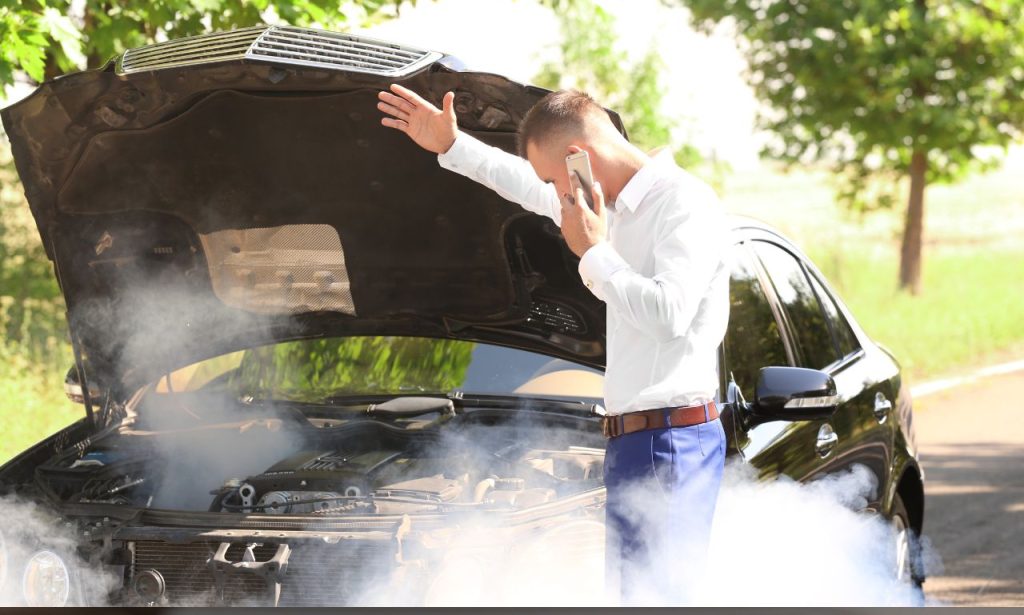You’re cruising down the highway, the open road stretching before you, when you pull up to a red light. Suddenly, you notice the temperature gauge creeping upward. You’re not even moving, yet your engine is threatening to overheat. This frustrating scenario, a car overheating at idle, can be a sign of several underlying issues. Understanding what causes a car to overheat at idle is crucial not only for addressing the immediate problem but also for preventing potentially costly engine damage. Let’s delve into the common culprits behind this automotive ailment and explore how you can keep your engine running cool, even during standstills.
Causes of Car Overheating at Idle
While overheating can occur at any speed, overheating specifically at idle often points to problems within the cooling system’s ability to function effectively at low speeds. Let’s examine the most common culprits:
1. Malfunctioning Cooling System

Your car’s cooling system is a complex network of components working in harmony to regulate engine temperature. A breakdown in any part of this system can lead to overheating, especially when the engine is idling and not benefiting from the airflow of driving speeds.
a) Broken Radiator Fan
The radiator fan plays a critical role in drawing air through the radiator when your car is stationary or moving at low speeds. When the vehicle is in motion, the natural airflow generated is often enough to cool the engine. However, at idle, this airflow is significantly reduced, making the fan essential. A broken fan, whether due to a faulty motor, damaged blades, or electrical issues, can lead to inadequate airflow and subsequent overheating.
b) Faulty Thermostat
The thermostat acts like a valve, regulating the flow of coolant between the engine and the radiator. When the engine is cold, the thermostat remains closed, allowing the engine to reach its optimal operating temperature quickly. As the engine heats up, the thermostat opens, allowing coolant to circulate and dissipate heat. A stuck closed thermostat restricts coolant flow, leading to overheating, particularly noticeable at idle when the engine relies heavily on proper coolant circulation.
c) Low Coolant Levels
Coolant, a mixture of water and antifreeze, is the lifeblood of your car’s cooling system. It absorbs heat from the engine and carries it to the radiator to be cooled. Low coolant levels, often caused by leaks or inadequate topping up, reduce the system’s ability to dissipate heat effectively, making overheating, especially at idle, more likely.
d) Coolant Leaks
Coolant leaks can occur in various parts of the cooling system, including hoses, the radiator, the water pump, and even the engine itself (head gasket failure). Even small leaks can gradually deplete coolant levels, compromising the system’s efficiency and increasing the risk of overheating, particularly noticeable at idle when the engine relies heavily on a consistent coolant volume for temperature regulation.
e) Radiator Problems
The radiator acts as a heat exchanger, transferring heat from the hot coolant to the cooler air passing through its fins. Over time, radiators can develop problems like clogging from debris, internal corrosion, or external damage, all of which hinder their ability to dissipate heat effectively. This inefficiency becomes more pronounced at idle when airflow through the radiator is reduced, potentially leading to overheating.
f) Failing Water Pump
The water pump is responsible for circulating coolant throughout the engine and the entire cooling system. A failing water pump, often due to a worn impeller or a leaking seal, can lead to reduced or completely halted coolant flow. This lack of circulation prevents heat dissipation, making overheating, particularly at idle when coolant flow is crucial for maintaining engine temperature, a significant risk.
2. Symptoms of Overheating
Timely identification of overheating is crucial to prevent severe engine damage. Familiarize yourself with these common warning signs:
a) Warning Lights
Most modern cars have a temperature warning light or gauge on the dashboard. A flashing or illuminated warning light, especially accompanied by a high-temperature reading on the gauge, is a clear indication of engine overheating and requires immediate attention.
b) Steam or Smoke from Engine
Seeing steam, especially white steam, rising from the front of your car, particularly near the engine bay, is a telltale sign of overheating. The steam is often coolant vaporizing due to extreme heat. Smoke, particularly with a sweet smell, can indicate a coolant leak coming into contact with hot engine components.
c) Unusual Engine Noises
Overheating can cause unusual engine noises, such as ticking, knocking, or pinging sounds. These noises often result from the engine’s metal components expanding and rubbing against each other due to excessive heat.
d) Temperature Gauge Indicators
Keep a close eye on your car’s temperature gauge while driving. If the needle consistently climbs towards the red zone, especially during idling or slow-moving traffic, it indicates that your engine is overheating and requires attention.
3. Consequences of Overheating
Ignoring an overheating engine can lead to catastrophic and costly engine damage. Here are some potential consequences:
a) Engine Damage
Excessive heat can warp engine components, damage seals and gaskets, and even cause the engine to seize. Repairing this level of damage can be extremely expensive, often requiring extensive engine work or even a complete engine replacement.
b) Failed Head Gasket
The head gasket seals the gap between the engine block and the cylinder head, preventing coolant and oil from mixing. Overheating can cause the head gasket to blow, leading to coolant leaks, white smoke from the exhaust, and potentially catastrophic engine damage.
c) Warped Cylinder Heads
Cylinder heads, which house the combustion chambers and valves, are particularly susceptible to warping under extreme heat. A warped cylinder head can lead to compression loss, reduced engine performance, and costly repairs.
4. Preventive Measures
Preventing overheating is far more cost-effective and less stressful than dealing with the consequences. Adopt these preventive measures to keep your car running cool:
a) Regular Maintenance Checks
Regular maintenance is crucial for preventing overheating. Adhere to your car’s recommended maintenance schedule, which includes coolant flushes, radiator inspections, and cooling system pressure tests.
b) Checking Coolant Levels
Regularly check your coolant levels when the engine is cold. If the coolant level is low, top it up with the correct mixture of coolant and water as specified in your car’s owner’s manual.
c) Inspecting the Cooling System
Visually inspect the cooling system components, including hoses, belts, and the radiator, for signs of wear and tear, leaks, or damage. Replace any worn or damaged components immediately.
d) Replacing Damaged Components

Address any cooling system problems promptly. Don’t delay in replacing damaged components like a worn water pump, a leaking radiator, or a faulty thermostat. Early intervention can prevent more severe and costly problems down the road.
Conclusion
Understanding what causes a car to overheat at idle empowers you to take proactive steps to prevent this frustrating and potentially damaging situation. Regular maintenance, vigilant monitoring of your car’s temperature, and addressing cooling system issues promptly are the keys to keeping your engine running cool and preventing costly repairs. Remember, a well-maintained cooling system is an investment in the longevity and reliability of your vehicle.
ALSO READ: What Type of Tracking Technologies VEI Employs
FAQs
This scenario often points to a problem with the cooling fan or a low coolant level. At higher speeds, the airflow through the radiator is sufficient to cool the engine, but at low speeds or idle, the fan plays a crucial role in drawing air through the radiator. A malfunctioning fan or insufficient coolant can lead to overheating in traffic conditions.
While a coolant flush is essential, other components might be contributing to the overheating issue. A faulty thermostat, a failing water pump, or even a leak in the cooling system could be the culprits. It’s crucial to have a mechanic inspect the entire cooling system to diagnose the root cause.
Yes, driving with an overheated engine, even for a short period, can cause damage. The extreme heat can warp engine components, damage seals, and even lead to engine seizure. It’s crucial to stop driving as soon as you notice signs of overheating to minimize potential damage.
It’s generally recommended to have your cooling system inspected by a mechanic at least once a year or as part of your car’s regular maintenance schedule. However, if you live in a hot climate or frequently drive in heavy traffic, more frequent inspections might be necessary.
The type of coolant suitable for your car is specified in your owner’s manual. Using the wrong type of coolant can damage your cooling system and lead to overheating. If you’re unsure, consult your mechanic or refer to your car’s owner’s manual.




